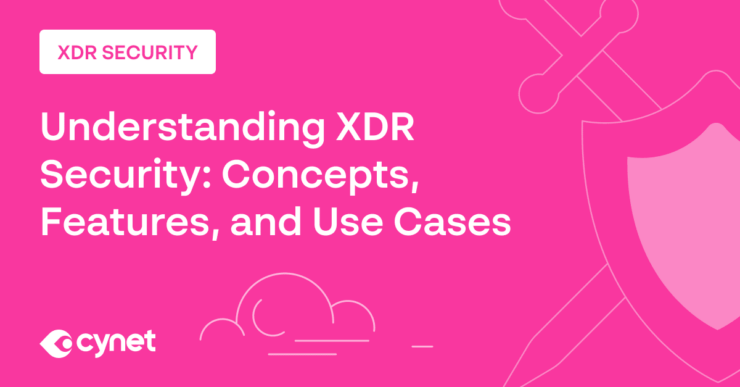January 28, 2025
Last Updated:
January 31, 2025
What Is Extended Detection and Response (XDR)?
Extended Detection and Response (XDR) is a cybersecurity framework that integrates multiple security products into a unified platform. The goal is to improve detection accuracy, simplify responses, and reduce operational complexities.
By correlating data from diverse security layers—such as endpoint, network, and server security—XDR provides visibility and helps in identifying complex threats that may otherwise evade point solutions.
XDR automates and simplifies the data collection process, enabling security teams to quickly detect and respond to threats. This integration enables a more holistic view of an organization’s security posture and improves threat detection capabilities. The correlation of data across disparate sources aids in uncovering threats and minimizes the noise caused by false positives.
What Is Security Orchestration, Automation, and Response (SOAR)?
Security Orchestration, Automation, and Response (SOAR) is a collection of software solutions and tools that help simplify security operations. SOAR enables security teams to collect data about security threats and coordinate responses. It integrates disparate tools and workflows, ensuring that responses are consistent and measured.
Automation of repetitive tasks is a significant component, allowing for quicker threat mitigation. SOAR solutions provide dashboards and reporting that deliver insights into security operations, helping teams prioritize tasks and actions based on threat levels.
By reducing the manual workload on security analysts, SOAR improves the speed and accuracy of security responses. The orchestration of various tools under a unified platform empowers teams to manage alerts and optimize security personnel’s productivity.
Key Features of XDR
XDR integrates and automates various security functions, providing a unified approach to threat detection and response. Its key features include:
- Cross-layer threat detection: Correlates data across endpoints, networks, servers, and other security layers to detect threats that siloed tools may miss.
- Unified threat visibility: Offers a centralized view of security data from multiple sources, improving situational awareness and reducing blind spots.
- Automated incident response: Simplifies responses by automating remediation steps, such as isolating infected systems or blocking malicious traffic.
- Analytics and AI: Uses machine learning and behavioral analysis to identify anomalies and detect advanced persistent threats (APTs).
- Reduction of false positives: Filters out noise by correlating alerts and providing context, enabling security teams to focus on real threats.
- Simplified security operations: Reduces the complexity of managing multiple security tools, improving the efficiency of security operations teams.
Key Features of SOAR
SOAR unifies, automates, and simplifies security operations. Its key features include:
- Incident response automation: Automates repetitive tasks such as log analysis, alert triage, and remediation actions, accelerating response times.
- Playbook integration: Allows the creation and execution of customizable workflows or playbooks for consistent, repeatable incident responses.
- Tool and workflow integration: Connects with various security tools, such as SIEM, endpoint detection, and threat intelligence platforms, for orchestration.
- Case management: Provides centralized case tracking, enabling analysts to document, monitor, and manage incidents.
- Dashboard and reporting: Offers visualizations and analytics to monitor security operations, assess KPIs, and track improvements over time.
- Threat intelligence enrichment: Enhances incident analysis by integrating threat intelligence feeds, providing context for better decision-making.
In my experience, here are tips that can help you effectively evaluate and implement XDR and SOAR solutions:
- Understand the maturity of your security operations: Assess whether the organization is equipped to handle a centralized detection system (XDR) or requires process automation (SOAR) to manage alert fatigue and improve workflows.
- Leverage SOAR as a complement to existing XDR tools: If you already use XDR, integrate SOAR for advanced automation and orchestration. SOAR’s playbooks can automate responses to XDR-detected threats, creating a seamless pipeline from detection to resolution.
- Align your solution choice with compliance needs: For organizations in regulated industries, SOAR can be customized to automate compliance workflows and generate audit-ready reports, while XDR can help ensure threats to sensitive data are detected and mitigated swiftly.
- Focus on interoperability: Prioritize XDR or SOAR platforms that support broad integration with existing security tools like SIEM, EDR, or threat intelligence feeds.
- Invest in threat intelligence feeds for both platforms: Enhance both XDR’s detection capabilities and SOAR’s response accuracy by integrating high-quality threat intelligence. This improves correlation accuracy and ensures that automated responses are based on actionable data.
Eyal Gruner is the Co-Founder and Board Director at Cynet. He served as the company’s CEO for nine years, guiding its growth from the very beginning. He is also Co-Founder and former CEO of BugSec, Israel’s leading cyber consultancy, and Versafe, acquired by F5 Networks. Gruner began his career at age 15 by hacking into his bank’s ATM to show the weakness of their security and has been recognized in Google’s security Hall of Fame.
XDR vs. SOAR: The Key Differences
XDR and SOAR both help improve security operations, but they approach this goal differently.
1. Focus
XDR focuses on unifying security telemetry to provide an integrated approach to threat detection and response. It pulls data from across platforms and correlates it to detect threats that an individual solution might miss. By centralizing detection efforts, XDR provides situational awareness, which is crucial for rapid threat identification and response.
SOAR focuses on process improvement and operational efficiency within a security operation center (SOC). It emphasizes orchestrating security workflows and automating incident responses, interlinking and managing different security tools and personnel.
2. Data Sources
XDR collects and correlates data from diverse security domains like endpoint, network, email, and cloud, offering threat visibility. This consolidated approach enables it to detect threats by analyzing cross-channel data, offering a deeper context for incident analysis. Better data correlation supports rapidly identifying multi-vector threats.
SOAR is predominantly focused on integrating data from existing security information management tools to orchestrate a unified response. SOAR platforms utilize data from various security systems to automate response actions and provide a simplified threat mitigation workflow.
3. Response Mechanism
XDR’s response mechanism is centralized, tying together data collection and analysis with automated responses to threats detected across various platforms. The integration of multiple security solutions ensures a quick and coordinated response.
SOAR excels in automating incident response tasks, reducing the dependency on manual intervention, and improving response speed and accuracy. By creating workflows and utilizing playbooks, SOAR platforms minimize human error and standardize responses to recurring threats.
4. Threat Management
XDR improves threat management by using analytics and machine learning to identify and respond to threats. Its holistic approach to threat detection includes aggregating and correlating telemetry from various endpoints, offering a more comprehensive defense against both known and emerging threats.
SOAR contributes to threat management by optimizing the efficiency of response processes. It provides a centralized platform for coordinating incident responses, ensuring that every threat is handled promptly according to standardized procedures.
5. Customizability
XDR solutions typically offer less customizability compared to SOAR, mainly due to their integrated nature aimed at optimizing detection and response efforts across standardized environments. They provide predefined settings and configurations intended to deliver threat management with minimal setup.
SOAR platforms are highly customizable, providing flexibility to design workflows that meet organizational needs. They allow security operations teams to create playbooks, leverage third-party integrations, and modify processes to suit their unique operational requirements.
6. Use Cases
XDR is ideally suited for organizations looking to improve their detection and response capabilities through a unified and integrated security approach. It is best employed in environments where threat visibility and rapid response are integral to maintaining security.
SOAR is particularly beneficial in improving operational efficiency for security teams overwhelmed with alerts and repetitive tasks. Organizations looking to simplify their security operations by automating processes and improving response times will find SOAR solutions advantageous.
SOAR vs. XDR: How to Choose?
Choosing between SOAR and XDR depends on an organization’s needs, existing security infrastructure, and operational priorities. Here are some key considerations to guide the decision-making process:
- Security goals: If the primary objective is improving threat detection and gaining deeper visibility across endpoints, networks, and other domains, XDR is the better choice. For organizations focused on simplifying operations, automating repetitive tasks, and optimizing response workflows, SOAR provides the required orchestration and automation capabilities.
- Team size and expertise: Smaller security teams with limited resources may benefit more from XDR, as it provides out-of-the-box integration and automated responses to improve threat detection without requiring significant customization. Larger teams with dedicated SOCs and experienced analysts may find SOAR more advantageous due to its high customizability and ability to improve operational efficiency through tailored workflows.
- Existing infrastructure: Organizations already leveraging detection tools like endpoint detection and response (EDR) or security information and event management (SIEM) may find XDR a natural extension, consolidating their threat detection efforts into a unified platform. SOAR is suitable for organizations seeking to improve their existing toolsets by integrating them under a single platform for simplified response and automation.
- Customization needs: XDR offers limited customization as it focuses on standardizing detection and response workflows, making it suitable for organizations prioritizing simplicity and consistency. SOAR provides extensive customization options, allowing security teams to design playbooks and processes for targeted threats.
- Budget and ROI: XDR can provide cost-effective solutions for organizations needing an all-in-one platform to improve detection and response capabilities without significant upfront investment in additional tools. SOAR may require a higher investment but delivers value through efficiency gains, reduced manual workload, and improved incident response times, particularly in large or complex environments.
- Threat landscape: Industries facing advanced persistent threats (APTs) or multi-vector attacks may benefit more from XDR’s cross-layer correlation and analytics capabilities. SOAR’s strength in incident response and orchestration makes it well-suited for organizations dealing with high alert volumes or repetitive threat scenarios.
Organizations often benefit from combining SOAR and XDR solutions to maximize their cybersecurity posture. While XDR strengthens detection and response across diverse security domains, SOAR ensures efficient orchestration and automation of incident responses.
Related content: Read our guide to XDR security solutions
Security Automation with Cynet
Cynet is the world’s first Autonomous Breach Protection platform that natively integrates the endpoint, network and user attack prevention & detection of XDR with the automated investigation and remediation capabilities of SOAR, backed by a 24/7 world-class MDR service. End to end, fully automated breach protection is now within reach of any organization, regardless of security team size and skill level.
XDR Layer: End-to-End Prevention & Detection
- Endpoint protection—multilayered protection against malware, ransomware, exploits and fileless attacks.
- Network protection—protecting against scanning attacks, MITM, lateral movement and data exfiltration.
- User protection—preset behavior rules coupled with dynamic behavior profiling to detect malicious anomalies.
- Deception—wide array of network, user, file decoys to lure advanced attackers into revealing their hidden presence.
SOAR Layer: Response Automation
- Investigation—automated root cause and impact analysis.
- Findings—actionable conclusions on the attack’s origin and its affected entities.
- Remediation—elimination of malicious presence, activity and infrastructure across user, network and endpoint attacks.
- Visualization—intuitive flow layout of the attack and the automated response flow.
MDR Layer: Expert Monitoring and Oversight
- Alert monitoring—First line of defense against incoming alerts, prioritizing and notifying customers on critical events.
- Attack investigation—Detailed analysis reports on the attacks that targeted the customer.
- Proactive threat hunting—Search for malicious artifacts and IoC within the customer’s environment.
- Incident response guidance—Remote assistance in isolation and removal of malicious infrastructure, presence and activity.
Simple Deployment
Cynet can be deployed across thousands of endpoints in less than two hours. It can be immediately used to uncover advanced threats and then perform automatic or manual remediation, disrupt malicious activity and minimize damage caused by attacks.
Get a free trial of Cynet and experience the world’s only integrated XDR, SOAR and MDR solution.



